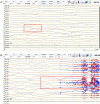Anti-amphiphysin encephalitis: Expanding the clinical spectrum
- PMID: 37090693
- PMCID: PMC10113538
- DOI: 10.3389/fimmu.2023.1084883
Anti-amphiphysin encephalitis: Expanding the clinical spectrum
Abstract
Objective: An analysis of the clinical features of autoimmune encephalitis accompanied by anti-amphiphysin antibodies.
Methods: The data of encephalitis patients with anti-amphiphysin antibodies were retrospectively evaluated, including demographics, neurological and laboratory findings, imaging, treatment, and prognostic predictions.
Results: Ten patients aged between 29 and 78 years (median age 52 years) were included. The male: female ratio was 4:6. Limbic encephalitis was found in nine patients while epileptic seizures were present in seven patients. All patients showed anti-amphiphysin antibody positivity in sera while one ninth was positive for CSF antibody. The EEG findings were abnormal, including reductions in background activity, and the presence of diffuse slow waves, sharp waves, and spikes and waves. Five patients showed signs of increased T2 signals in the medial temporal lobe on MRI while PET showed either hyper- or hypo-metabolic changes in several brain regions, including the temporal lobe, hippocampus, basal ganglia, frontal and parietal cortices. Nine of ten patients were treated with immunotherapy, with improvements of varying degrees. There was a significant reduction in seizure frequency, and all patients were seizure-free at last follow-up.
Conclusion: Autoimmune encephalitis with anti-amphiphysin antibodies has a variety of clinical manifestations. The most common symptom is limbic encephalitis. Although relief from seizures can be achieved relatively easily, many patients suffer psychiatric, cognitive, and sleep sequelae. The disease was found to be associated with a lower incidence of cancer than has been previously reported for paraneoplastic neurologic syndromes.
Keywords: amphiphysin; autoimmune encephalitis; clinical features; prognosis; treatment.
Copyright © 2023 Sun, Qin, Huang, Zhou, Zhang and Wang.
Conflict of interest statement
The authors declare that the research was conducted in the absence of any commercial or financial relationships that could be construed as a potential conflict of interest.
Figures



Similar articles
-
A case report of anti-GAD65 antibody-positive autoimmune encephalitis in children associated with autoimmune polyendocrine syndrome type-II and literature review.Front Immunol. 2023 Nov 22;14:1274672. doi: 10.3389/fimmu.2023.1274672. eCollection 2023. Front Immunol. 2023. PMID: 38077387 Free PMC article. Review.
-
Clinical Character of CASPR2 Autoimmune Encephalitis: A Multiple Center Retrospective Study.Front Immunol. 2021 May 13;12:652864. doi: 10.3389/fimmu.2021.652864. eCollection 2021. Front Immunol. 2021. PMID: 34054814 Free PMC article.
-
Clinical features of nine cases of leucine-rich glioma inactivated 1 protein antibody-associated encephalitis.Acta Neurol Belg. 2021 Aug;121(4):889-897. doi: 10.1007/s13760-020-01336-z. Epub 2020 Mar 31. Acta Neurol Belg. 2021. PMID: 32232701
-
Clinical Characteristics of Anti-GABA-B Receptor Encephalitis.Front Neurol. 2020 May 21;11:403. doi: 10.3389/fneur.2020.00403. eCollection 2020. Front Neurol. 2020. PMID: 32508739 Free PMC article.
-
Typical clinical and imaging manifestations of encephalitis with anti-γ-aminobutyric acid B receptor antibodies: clinical experience and a literature review.Neurol Sci. 2019 Apr;40(4):769-777. doi: 10.1007/s10072-018-3679-5. Epub 2019 Jan 22. Neurol Sci. 2019. PMID: 30671737 Review.
Cited by
-
Breast cancer's hidden partner: meningoencephalitis as a paraneoplastic revelation: a rare presentation of invasive ductal carcinoma of breast: a case report.Ann Med Surg (Lond). 2023 Nov 16;86(1):512-516. doi: 10.1097/MS9.0000000000001499. eCollection 2024 Jan. Ann Med Surg (Lond). 2023. PMID: 38222730 Free PMC article.
-
Effectiveness of Intravenous Cyclophosphamide in a Patient With Anti-amphiphysin Autoimmunity Presenting With Bulbar Palsy and Cerebellar Ataxia: A Case Report.Cureus. 2024 Jul 25;16(7):e65350. doi: 10.7759/cureus.65350. eCollection 2024 Jul. Cureus. 2024. PMID: 39184604 Free PMC article.
-
MR Imaging Findings in Anti-Leucine-Rich Glioma Inactivated Protein 1 Encephalitis: A Systematic Review and Meta-analysis.AJNR Am J Neuroradiol. 2024 Jul 8;45(7):977-986. doi: 10.3174/ajnr.A8256. AJNR Am J Neuroradiol. 2024. PMID: 38871367 Free PMC article.
-
Isolated Choreic Manifestations Indicative of Anti-Amphiphysin Antibody-Related Encephalitis in Breast Cancer.Mov Disord. 2025 May;40(5):986-989. doi: 10.1002/mds.30140. Epub 2025 Mar 5. Mov Disord. 2025. PMID: 40042056 Free PMC article. No abstract available.
-
A Systematic Review of Sporadic Creutzfeldt-Jakob Disease: Pathogenesis, Diagnosis, and Therapeutic Attempts.Neurol Int. 2024 Sep 20;16(5):1039-1065. doi: 10.3390/neurolint16050079. Neurol Int. 2024. PMID: 39311352 Free PMC article. Review.
References
Publication types
MeSH terms
Substances
Supplementary concepts
LinkOut - more resources
Full Text Sources
Medical

